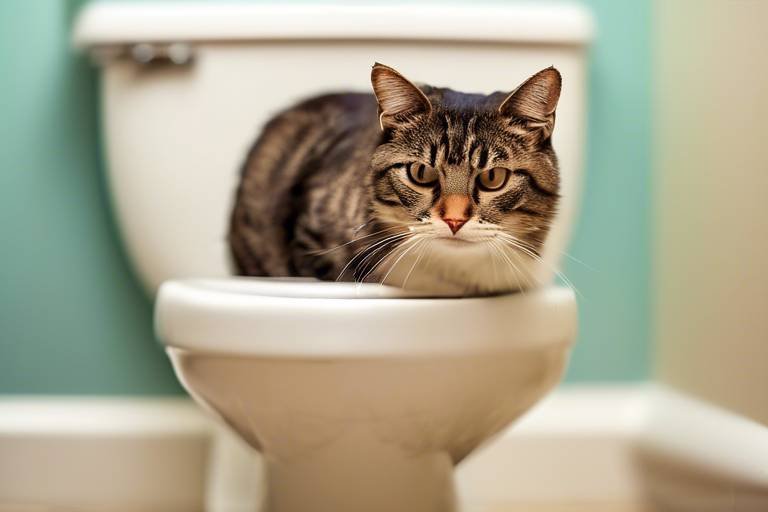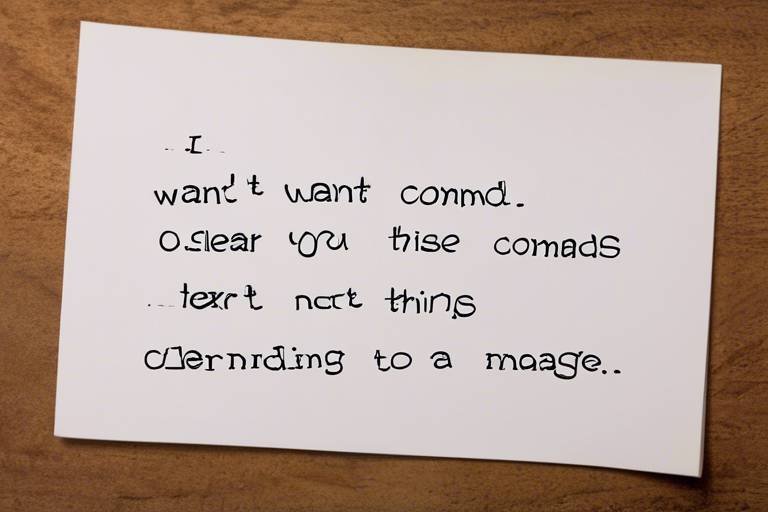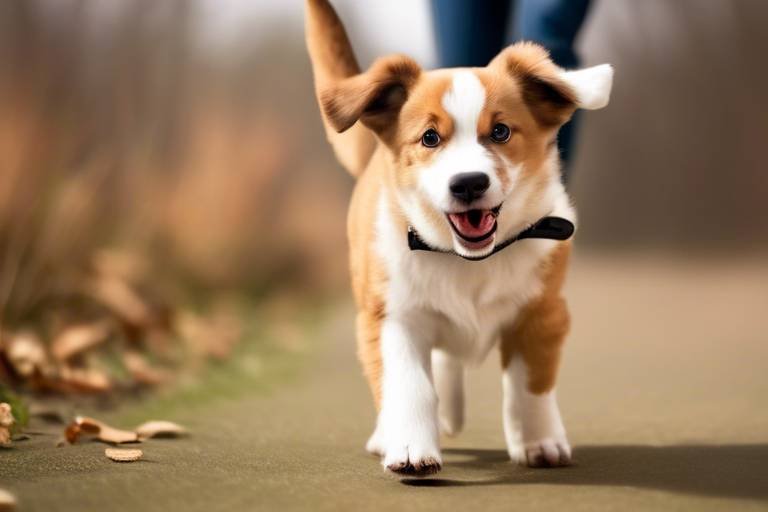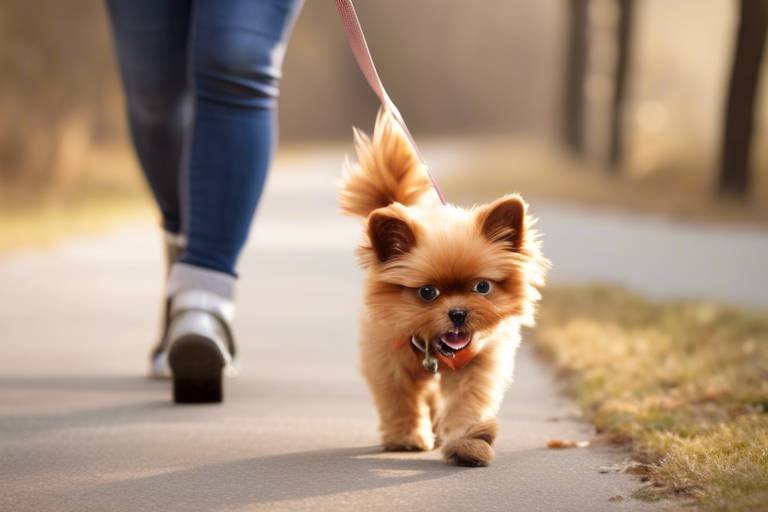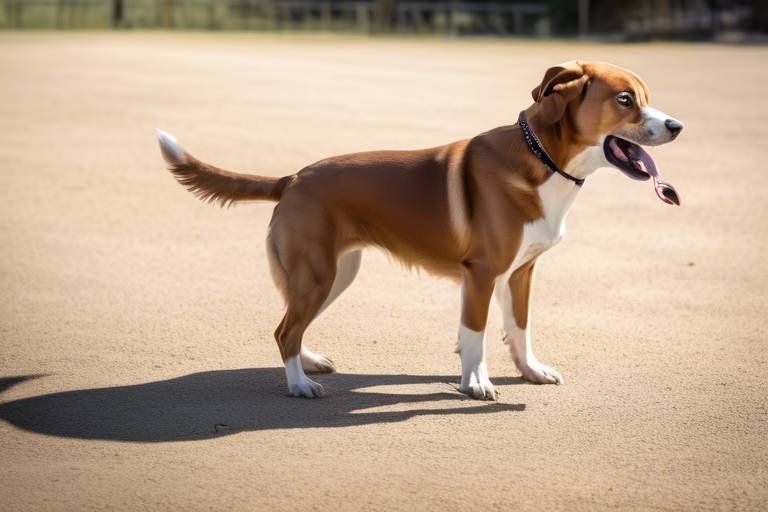How to Train Your Pet to Respond to Hand Gestures
Training your pet to respond to hand gestures is not just a fun trick; it can significantly enhance the way you communicate with your furry companion. Imagine being able to tell your dog to sit or come without uttering a single word! This method of training can be especially beneficial in noisy environments or when your pet is distracted. Plus, it strengthens the bond between you and your pet, creating a unique language that only the two of you share.
Before diving into the techniques, it’s essential to understand that pets, just like humans, have their own ways of learning. They rely heavily on visual cues and body language, which makes hand gestures an effective training tool. Think of your pet as a sponge, ready to soak up information from your movements. By using clear and consistent gestures, you can tap into their natural instincts and create a communication channel that is both intuitive and rewarding.
Throughout this article, we will explore various aspects of training your pet to respond to hand gestures, from understanding their behavior to choosing the right signals. We will also discuss the importance of consistency, positive reinforcement, and tracking progress to ensure your training sessions are productive. So, let’s get started on this exciting journey to better communication with your four-legged friend!
Gaining insight into your pet's behavior is crucial for effective training. Pets have unique instincts and learning processes that can aid in training them to respond to gestures. For instance, dogs are naturally inclined to observe their owners closely, picking up on subtle cues. This ability can be harnessed to teach them new commands through hand signals. Understanding how your pet learns can help you tailor your approach. Are they more visual learners? Or do they respond better to auditory cues? Knowing this can guide your training methods.
Selecting clear and consistent hand signals is essential for training success. You want to choose gestures that are easy for your pet to recognize and remember. For example, a simple open palm can signify "stay," while a pointed finger can indicate "come." The key is to keep the signals distinct from one another to avoid confusion. Additionally, using gestures that mimic the action you want your pet to take can be incredibly helpful. For instance, moving your hand downward can signal your pet to sit.
Consistency in using hand signals reinforces learning. Imagine trying to learn a new language where the words change meaning every time you hear them. Frustrating, right? Your pet feels the same way! By using the same gestures every time, you help your pet make a clear connection between the signal and the action. Regular practice is vital; make it a part of your daily routine. The more your pet sees and responds to the signals, the more ingrained the behavior will become.
Positive reinforcement is a powerful training tool. When your pet responds correctly to a hand gesture, reward them immediately with treats, praise, or a favorite toy. This not only encourages the desired behavior but also builds a positive association with the gesture. Think of it as a high five for your pet; they love the acknowledgment and will be more likely to repeat the behavior. The joy in their eyes when they receive a reward is priceless!
Proper timing of rewards is key to successful training. Imagine if you were rewarded for a job well done, but the acknowledgment came days later. You might forget what you did to earn that praise! The same goes for pets. When your furry friend responds to a gesture, reward them immediately. This strengthens the association between the hand signal and the action, making it more likely they’ll remember it for next time.
Avoiding common training pitfalls can lead to more effective results. One frequent mistake is using multiple signals for the same command, which can confuse your pet. Stick to one clear gesture for each command. Another mistake is not being patient. Training takes time, and every pet learns at their own pace. Celebrate small victories along the way, and remember that consistency and patience are your best friends in this journey.
Establishing a consistent training schedule is vital for success. Just like humans, pets thrive on routine. Set aside specific times each day for training sessions, making it a fun and engaging experience. This not only helps your pet anticipate the training but also allows them to focus better. You can even incorporate training into playtime, making it feel less like a chore and more like a bonding activity.
Short and frequent training sessions are more effective than long ones. Pets, especially dogs, have a limited attention span. Keeping sessions brief—around 5 to 10 minutes—helps maintain your pet's enthusiasm and focus. Think of it like a quick workout; it’s better to have multiple short bursts of activity than one long session that leaves you both drained. Plus, this approach allows you to cover more ground over time.
Monitoring your pet's progress helps adjust training methods as needed. Keeping a training journal can be incredibly useful. Note down which gestures your pet responds to, their progress, and any challenges faced. This not only helps you stay organized but also allows you to celebrate milestones along the way. Remember, training is a journey, and each step forward is worth acknowledging!
- How long does it take to train my pet to respond to hand gestures? Training duration varies by pet and depends on consistency and practice. Some pets may catch on quickly, while others may take more time.
- Can I use hand gestures with any type of pet? Yes! Most pets, including dogs, cats, and even some small animals, can learn to respond to hand signals.
- What if my pet doesn't respond to a gesture? It’s essential to stay patient. Revisit the gesture and ensure it is clear and consistent. Reward them when they do respond correctly.

Understanding Pet Behavior
Gaining insight into your pet's behavior is crucial for effective training. Just like humans, pets have their own unique ways of learning and communicating. Understanding these natural instincts can significantly enhance your training experience. For instance, did you know that dogs are incredibly attuned to body language? This means that they often pick up on non-verbal cues even before you utter a word! By tapping into this instinct, you can create a more engaging and responsive training environment.
The learning process of pets is fascinating and varies among species. For instance, dogs are pack animals and thrive on social interaction, while cats are more independent and may require different approaches. Understanding these differences can help you tailor your training methods to suit your pet's personality. In fact, many pets learn better through observation. If they see another animal responding to a hand gesture, they are likely to mimic that behavior. This is why it's essential to train in a distraction-free environment where your pet can focus solely on you.
Moreover, pets communicate through a combination of vocalizations, body language, and even facial expressions. For example, a wagging tail may indicate excitement or happiness, while a lowered head could signify submission or fear. Recognizing these signals can help you understand your pet's mood and readiness to learn. Here are a few key behaviors to observe:
- Tail Position: A high tail often means your pet is happy and confident, while a low tail may indicate anxiety.
- Ear Position: Ears perked up show curiosity, while flattened ears can signal discomfort or fear.
- Body Posture: An open posture suggests a relaxed pet, whereas a tense body may indicate stress.
By combining your knowledge of pet behavior with effective training techniques, you can create a strong bond with your furry friend. Remember, the key to successful training is patience and understanding. Every pet learns at their own pace, and recognizing their individual quirks will help you adjust your methods accordingly. As you embark on this training journey, keep in mind that the goal is not only to teach your pet but also to enhance your relationship with them. After all, a well-trained pet is not just a joy to have but also a wonderful companion!

Choosing the Right Hand Signals
When it comes to training your pet, is crucial for effective communication. Just like you wouldn't use a foreign language to talk to a friend who doesn’t speak it, using unclear or inconsistent gestures can confuse your furry companion. So, what makes a hand signal effective? Let's break it down!
First off, you want to ensure that your hand signals are clear and distinct. This means avoiding gestures that look similar to each other. For example, if you use a wave for "come here" and a similar motion for "sit," your pet may get mixed signals. Instead, think about using a specific gesture for each command. For instance, a simple upward motion of your hand could mean "sit," while a sweeping motion to the side could indicate "stay." The more unique your gestures, the easier it will be for your pet to understand.
Consistency is key! Once you've selected your hand signals, stick with them. If you change gestures frequently, your pet will be left scratching their head (or pawing at the ground) in confusion. It’s like trying to learn a new dance when the steps keep changing every few minutes. To help with this, consider keeping a training log where you note down the gestures you are using and any modifications you might want to make in the future.
Additionally, it’s essential to choose gestures that are easy for your pet to see. If you have a small dog, for example, a low hand signal might be difficult for them to see, especially if they’re excited and jumping around. Try to keep your signals at a height that’s easily visible to your pet. You might even want to practice your gestures in front of a mirror to ensure they are noticeable and clear.
Now, let’s talk about context. Your hand signals should be used in conjunction with verbal commands initially. This dual approach helps your pet make the connection between the sound of your voice and the movement of your hands. For example, when you say "sit," simultaneously use the hand signal you've chosen. Over time, as your pet begins to understand the hand gesture alone, you can gradually phase out the verbal cue. This method not only strengthens their learning but also enhances the bond between you two, as they learn to read your body language.
Lastly, remember to incorporate positive reinforcement whenever your pet successfully responds to a hand signal. This can be in the form of treats, praise, or even a favorite toy. A little encouragement goes a long way in reinforcing good behavior and making training a fun experience for both of you!
In summary, selecting the right hand signals involves clarity, consistency, visibility, context, and positive reinforcement. By keeping these elements in mind, you’ll set your pet up for success and create a stronger, more communicative bond. So go ahead and start experimenting with your gestures—your furry friend will thank you!
- What if my pet doesn’t respond to hand signals? - Be patient! It takes time for pets to learn. Ensure you are consistent with your signals and use positive reinforcement.
- Can I use hand signals with verbal commands? - Absolutely! In fact, using both together can help your pet learn faster.
- How long should training sessions last? - Keep them short and fun! Aim for about 5-10 minutes, several times a day.
The Importance of Consistency
When it comes to training your pet to respond to hand gestures, consistency is key. Just like humans, pets thrive on routine and clear expectations. Imagine trying to learn a new language where the rules change every day; it would be confusing, right? The same principle applies to our furry friends. By using the same hand signals consistently, you help your pet understand what you want from them, making the learning process smoother and more effective.
Think about it: if you were to teach your dog to sit using different gestures every time, they would likely become frustrated and confused. Instead, by sticking to one specific hand signal for each command, you create a clear line of communication. This not only helps your pet learn faster but also builds their confidence in responding to your cues. Imagine the joy of seeing your pet sit on command with just a simple wave of your hand!
To ensure consistency, consider the following strategies:
- Use the Same Signals: Make sure that every family member uses the same hand gestures for commands. If one person uses a sweeping motion while another uses a finger point, your pet will struggle to understand what’s expected.
- Practice Regularly: Consistent practice reinforces learning. Schedule daily training sessions, even if they’re just a few minutes long, to keep the signals fresh in your pet’s mind.
- Stay Patient: Remember that learning takes time. If your pet doesn’t respond immediately, don’t get discouraged. Stay calm and continue to use the same hand signals.
By committing to these practices, you’ll create a predictable environment for your pet, which is essential for effective training. The more consistent you are, the more your pet will associate specific gestures with actions. Over time, this will lead to a stronger bond between you and your furry friend, as they will not only learn to respond to your commands but also feel more secure in their understanding of your expectations.
In conclusion, consistency in using hand signals is a fundamental aspect of training your pet. It simplifies the learning process, enhances communication, and ultimately leads to a more harmonious relationship. So, the next time you train your pet, remember that being consistent is not just important; it’s essential for success!
Using Positive Reinforcement
When it comes to training your pet, positive reinforcement is like a secret weapon. Imagine this: you’re at a party, and someone hands you a cupcake every time you say a funny joke. What would you do? You’d probably tell more jokes, right? That’s the essence of positive reinforcement in pet training! By rewarding your furry friend for correctly responding to your hand gestures, you’re not just teaching them a trick; you’re creating a fun and engaging learning environment.
So, how does this work in practice? First, it’s essential to choose the right rewards. Some pets might go wild for treats, while others might prefer a good scratch behind the ears or a favorite toy. Here’s a quick guide to help you decide:
| Type of Reward | Best For |
|---|---|
| Treats | Food-motivated pets |
| Verbal Praise | Pets who thrive on attention |
| Playtime | Active pets who love to play |
| Affection | Pets that enjoy cuddles and pets |
Once you’ve figured out what makes your pet tick, it’s time to put it into action. When your pet successfully responds to a hand gesture, immediately reward them. This swift response helps your pet make the connection between the gesture and the reward. For instance, if you raise your hand and your dog sits, don’t wait! Give them a treat right away. This creates a strong association that reinforces the behavior.
But remember, it’s not just about the treats. Your enthusiasm matters! Pets are incredibly perceptive and can sense your excitement. If you celebrate their achievements with a cheerful voice and happy demeanor, it amplifies their eagerness to learn. Think of it as throwing a mini celebration every time they get it right. This positive atmosphere not only strengthens your bond but also makes training sessions something your pet looks forward to.
As you continue training, it's crucial to keep the rewards varied. If you always use the same treat, your pet may become less excited over time. Mix it up! Use different types of rewards or even alternate between treats and playtime. This keeps your pet engaged and eager to participate. And don’t forget to gradually reduce the frequency of treats as your pet becomes more proficient. You want them to respond to your gestures out of habit, not just for the food!
In summary, positive reinforcement is a fantastic way to train your pet to respond to hand gestures effectively. By selecting the right rewards, timing them perfectly, and keeping the training sessions enjoyable, you’ll not only teach your pet new tricks but also strengthen your relationship. It’s a win-win situation!
- What is positive reinforcement? Positive reinforcement is a training method that involves rewarding desired behaviors to encourage them in the future.
- How do I know what motivates my pet? Observe your pet's reactions to different stimuli, such as treats, toys, or praise, to determine what they respond to best.
- Can I use positive reinforcement for all types of pets? Yes! Positive reinforcement can be effective for a variety of pets, including dogs, cats, and even small animals.
- How long does it take to train a pet using positive reinforcement? The time varies by pet and the complexity of the behavior being taught, but consistency and patience are key.
Timing Your Rewards
When it comes to training your pet, timing is everything. Imagine this: you’ve just taught your furry friend a new hand gesture, and they finally respond correctly. What do you do next? If you hesitate or wait too long to reward them, that moment of success can quickly fade away, and your pet might not make the connection between the gesture and the reward. This is why immediate reinforcement is crucial. It’s like catching a wave at just the right moment – if you miss it, you’ll be left splashing in the water instead of riding high on your board.
To effectively reinforce your pet's behavior, aim to give them a treat or verbal praise within a second or two of their correct response. This immediate feedback helps strengthen their understanding of what you want them to do. Think of it as a high-five for a job well done! The faster they receive their reward, the more likely they are to associate the gesture with the positive outcome.
Here’s a handy tip: keep your treats within reach during training sessions. This way, you can quickly reward your pet without breaking the flow of the training. If you have to fumble around looking for treats, you risk losing your pet's attention, and nobody wants that! Plus, having a consistent reward system creates a routine that your pet can rely on.
Another important aspect to consider is the type of reward you use. Some pets respond better to treats, while others might be more motivated by praise or playtime. It’s essential to know your pet’s preferences. For instance, if your dog lights up at the sound of their favorite toy, consider using that as a reward. Here’s a quick breakdown:
| Type of Reward | Best For |
|---|---|
| Treats | Food-motivated pets |
| Praise | Affectionate pets |
| Playtime | Energetic pets |
Finally, keep in mind that isn’t just about speed; it’s also about consistency. Each time your pet responds to a hand gesture, make sure to reward them in the same way, whether it’s with a treat, verbal praise, or a quick game of fetch. This consistency reinforces their learning and builds a strong bond of trust between you and your furry companion.
In summary, the key to successful training lies in the immediacy and consistency of your rewards. When your pet responds to a hand gesture, reward them right away, choose a type of reward that resonates with them, and be consistent in your approach. By doing so, you’ll create a positive learning environment that encourages your pet to continue responding to your gestures with enthusiasm!
- How long should I wait before rewarding my pet? Aim to reward your pet within 1-2 seconds of their response to reinforce the behavior effectively.
- What if my pet doesn’t seem motivated by treats? Experiment with different rewards, such as praise or playtime, to find what motivates them best.
- Can I use the same reward for every command? Yes, but varying the rewards can keep your pet engaged and excited about training.
Common Mistakes to Avoid
When it comes to training your pet to respond to hand gestures, it's easy to fall into a few common traps that can hinder your progress. First and foremost, one of the biggest mistakes is inconsistency in using hand signals. Imagine trying to learn a new language where the words keep changing every time you hear them! Your pet can become confused if you use different gestures for the same command. To avoid this, pick a set of clear and distinct gestures and stick to them. Consistency is key!
Another frequent error is not paying attention to your pet's body language. Pets communicate a lot through their actions and expressions. If your furry friend seems disinterested or confused, it might be a sign that the training session is too long or that the hand signals are unclear. Always be observant; if your pet isn't responding, it might be time to reassess your approach.
Additionally, many pet owners overlook the importance of timing when rewarding their pets. Imagine if you were praised for doing something right, but the compliment came hours later; it wouldn't have the same impact, right? The same goes for your pet. Rewards should be given immediately after they successfully respond to a hand gesture to reinforce the behavior. This quick feedback helps your pet make the connection between the gesture and the desired action.
Lastly, avoid the temptation to overwhelm your pet with too many commands at once. Just like humans, pets can only absorb so much information at a time. Keep training sessions focused on one or two gestures until your pet masters them before introducing new ones. This approach not only makes it easier for your pet to learn but also keeps them engaged and excited about training.
In summary, by being consistent with your hand signals, paying close attention to your pet's reactions, timing your rewards perfectly, and not overloading your furry friend with too many commands, you can significantly enhance your training outcomes. Remember, training should be a fun and rewarding experience for both you and your pet!
- How long should training sessions last? Training sessions should ideally be short, around 5-10 minutes, to keep your pet engaged.
- Can I use gestures for commands other than sit and stay? Absolutely! You can use hand gestures for various commands like come, heel, and even tricks like roll over.
- What if my pet doesn't respond to the gestures? If your pet isn't responding, revisit your consistency, check if the gestures are clear, and ensure you're timing your rewards correctly.
- How often should I practice? Daily practice is ideal, but even a few times a week can be effective if done consistently.
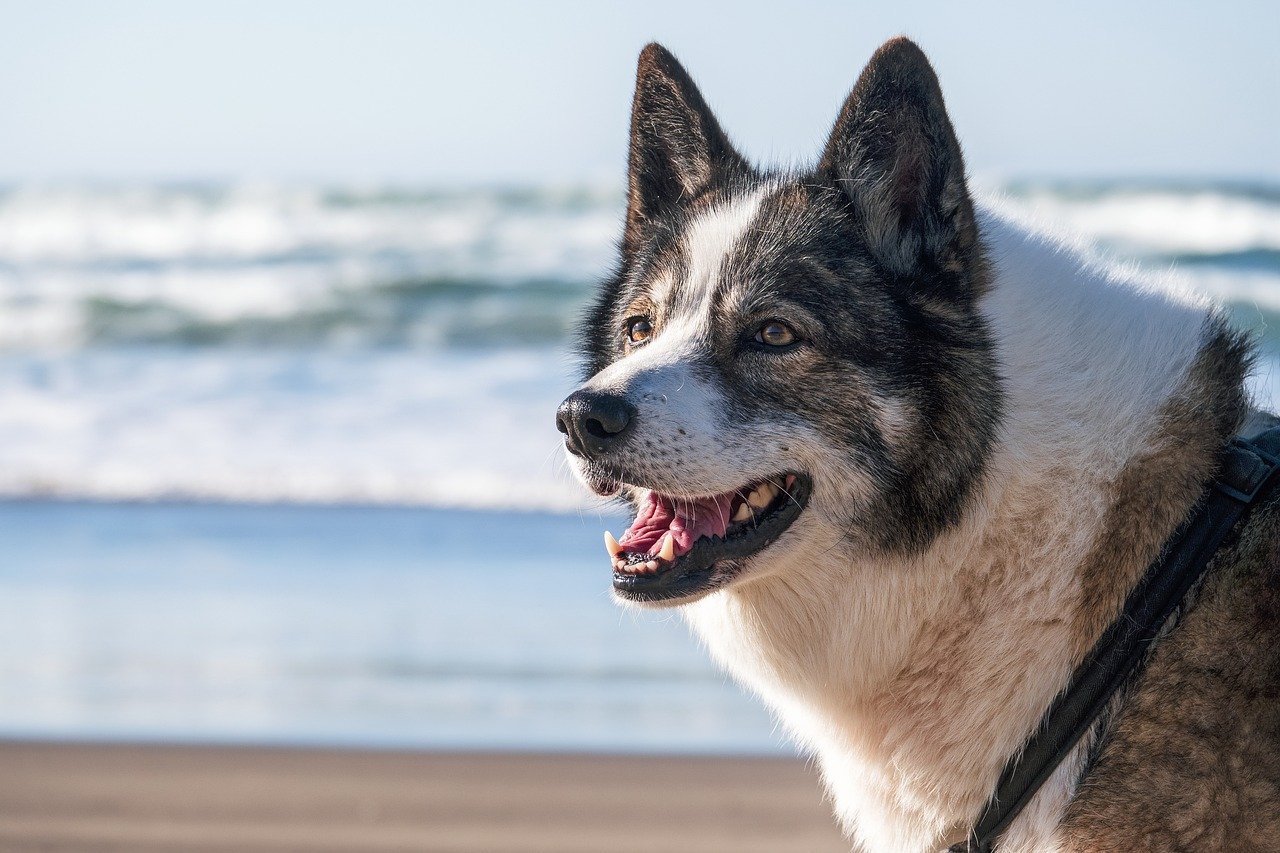
Creating a Training Schedule
Establishing a consistent training schedule is vital for success when it comes to teaching your pet to respond to hand gestures. Think of it like building a house; without a solid foundation, everything else is bound to crumble. A well-structured training schedule not only helps your pet learn faster but also strengthens the bond you share. So, how do you go about creating this schedule? Let’s break it down!
First and foremost, you want to consider your pet's natural rhythms. Just like humans, pets have times of day when they are more alert and receptive to learning. For instance, if your furry friend is a morning person, try scheduling training sessions shortly after breakfast when they are energized and eager to engage. Conversely, if they tend to be more active in the evening, that might be your golden hour for training.
Next, keep in mind that short, frequent sessions are often much more effective than longer, drawn-out ones. Imagine trying to concentrate on a lecture that goes on for hours—your mind would likely wander! The same goes for pets. Aim for sessions that last around 5 to 10 minutes, and ideally, you should try to train multiple times throughout the day. This keeps your pet engaged and prevents them from becoming bored or frustrated.
To help you visualize your training schedule, consider using a simple table format that outlines the days of the week, the duration of each session, and the specific hand gestures you plan to focus on. Here’s an example:
| Day | Time | Duration | Gesture Focus |
|---|---|---|---|
| Monday | 9:00 AM | 10 mins | Sit |
| Wednesday | 6:00 PM | 10 mins | Stay |
| Friday | 3:00 PM | 10 mins | Come |
In addition to the schedule itself, it’s important to remain flexible. Life can throw curveballs, and sometimes you might need to adjust your training times. If you notice your pet is particularly restless or distracted, it might be worth skipping a session and trying again later. The key is to be patient and responsive to your pet’s needs.
Lastly, tracking progress is crucial for understanding how well your pet is responding to the training. You might want to keep a simple journal or log where you note down your pet’s achievements and any challenges faced during training. This not only helps you stay organized but also allows you to celebrate the little victories along the way!
In conclusion, creating a training schedule is an essential step in teaching your pet to respond to hand gestures effectively. By considering your pet’s natural tendencies, keeping sessions short and engaging, and remaining flexible, you can create a positive learning environment that fosters growth and strengthens your bond. So grab that schedule, and let the training begin!
- How long should each training session last? Ideally, keep sessions between 5 to 10 minutes to maintain your pet's attention.
- How often should I train my pet? Aim for multiple short sessions throughout the day to reinforce learning.
- What if my pet isn't responding? Be patient and adjust your training methods; some pets may require more time to grasp new gestures.
Short, Frequent Sessions
When it comes to training your pet, the mantra of "short and sweet" is your best friend. Imagine trying to teach a toddler how to ride a bike for hours on end; they’d likely lose interest and become frustrated. The same principle applies to our furry companions. not only keep your pet engaged but also make learning a delightful experience rather than a chore. Aiming for sessions that last anywhere from 5 to 10 minutes is ideal. This way, your pet stays focused, and you both can have fun without the risk of burnout.
Think about it: when you’re excited about something, wouldn’t you prefer to dive in for a quick burst of activity rather than slogging through a long, tedious session? The same goes for your pet. Frequent, bite-sized training sessions help reinforce the behaviors you want while keeping your pet eager to learn. You can easily fit these sessions into your daily routine, whether it’s during a quick break at work or after a fun walk in the park.
To illustrate the effectiveness of short sessions, consider this: a study showed that pets trained in 5-minute intervals retained information better than those subjected to longer sessions. You might be wondering how to structure these training bursts. Here’s a simple breakdown:
| Time of Day | Activity | Duration |
|---|---|---|
| Morning | Basic Commands (Sit, Stay) | 5 minutes |
| Afternoon | New Tricks (Roll Over, Play Dead) | 10 minutes |
| Evening | Review Session (Mix of Commands) | 5 minutes |
This table serves as a guide to help you integrate training into your daily life. The key is to keep the sessions varied and fun, so your pet looks forward to them. Additionally, always end on a positive note; if your pet successfully responds to a gesture, shower them with praise or a treat. This will make them associate training with good vibes, and they’ll be more likely to engage in future sessions.
In summary, adopting a strategy of short, frequent training sessions is a game changer. Not only does it enhance your pet’s ability to learn and respond to hand gestures, but it also strengthens the bond between you two. So, set your timer, grab some treats, and get ready for some fun-filled training moments!
- How long should each training session last? Aim for 5 to 10 minutes per session to keep your pet engaged.
- How often should I train my pet? Daily training is ideal, but even a few times a week can be beneficial.
- What if my pet isn’t responding? Try changing your hand signals or rewards, and ensure you're in a distraction-free environment.
- Is it okay to train my pet when they’re tired? It’s best to train when your pet is alert and energetic for optimal results.
Tracking Progress
Tracking your pet's progress during training is not just a good idea—it's essential! Think of it like keeping score in a game; it helps you see how well your furry companion is learning and where adjustments might be needed. As you embark on this journey of training your pet to respond to hand gestures, maintaining a record can illuminate the path to success and ensure both you and your pet stay motivated.
One effective way to track progress is by keeping a training journal. In this journal, you can note down each session's date, duration, and the specific hand gestures practiced. Additionally, jot down your pet's responses—were they quick to respond or did they seem confused? This kind of detailed record can help you identify patterns over time. For example, if you notice your pet struggles with a particular gesture, you can adapt your training approach accordingly.
Moreover, using a simple progress chart can be a fun way to visualize your pet’s learning journey. You can create a table like the one below to log the dates and the gestures practiced, along with your pet's responsiveness:
| Date | Gesture | Response (1-5) | Notes |
|---|---|---|---|
| 01/01/2023 | Wave | 4 | Responded well, but hesitated. |
| 01/03/2023 | Point | 5 | Immediate response! |
| 01/05/2023 | Finger Snap | 3 | Looked confused; need to reinforce. |
Another practical method is to use video recordings. By filming your training sessions, you can review the footage later to assess your pet's performance. This can be particularly helpful in spotting subtle cues or miscommunications that might not be apparent in the moment. Plus, it’s a great way to celebrate milestones; you can look back on early sessions and see just how far your pet has come!
Don’t forget to celebrate the small victories along the way! Recognizing progress, no matter how minor, can boost both your spirits and your pet's motivation. Use treats, praise, or even a favorite toy to reward your pet when you notice improvement. Remember, training should be a fun and fulfilling experience for both of you!
Lastly, consider involving a friend or family member in your training sessions. Having another set of eyes can provide additional insights into your pet's behavior and progress. They might notice things you overlook or offer suggestions that can enhance your training technique.
In summary, tracking your pet's progress is a vital component of effective training. By maintaining a detailed journal, using progress charts, recording training sessions, and celebrating achievements, you can ensure that you and your furry friend are on the right path toward mastering hand gestures together. So grab that pen and paper—or your smartphone—and start documenting your training journey today!
- How long does it take for a pet to learn hand gestures?
Every pet is different! Some may pick up on gestures within a few sessions, while others may take weeks. Patience and consistency are key.
- What if my pet doesn’t respond to a gesture?
Don’t worry! It could be that the gesture isn’t clear enough or that your pet needs more practice. Try simplifying the gesture or breaking it down into smaller steps.
- Can I train an older pet?
Absolutely! Older pets can learn new tricks, too. Just be mindful of their physical limitations and adjust your training accordingly.
Frequently Asked Questions
- What types of pets can be trained to respond to hand gestures?
Almost any pet can be trained to respond to hand gestures! Dogs and cats are the most common, but even smaller animals like rabbits and birds can learn to recognize specific signals. The key is to be patient and consistent in your training methods.
- How long does it take for my pet to learn hand gestures?
The time it takes varies by pet and the complexity of the gestures. Generally, you might see some response within a few days to weeks. Regular practice is crucial, so keeping sessions short but frequent can help speed up the learning process!
- Can I use hand gestures along with verbal commands?
Absolutely! In fact, combining hand gestures with verbal commands can reinforce learning. Your pet will benefit from the added cues, making it easier for them to understand what you want. Just be sure to use the same gestures consistently.
- What if my pet doesn’t respond to the hand signals?
If your pet isn’t responding, don’t worry! It may just need more time or a different approach. Ensure that the gestures are clear, and try using positive reinforcement to encourage them. Sometimes, changing the environment or minimizing distractions can also help.
- How can I tell if my pet is learning?
Look for signs of recognition! If your pet starts to look at you when you use a hand signal or attempts to perform the desired behavior, that’s a great sign they’re learning. Keeping a training log can help you track their progress over time.
- Is it necessary to use treats during training?
While treats can be a great motivator, they aren’t strictly necessary. You can also use praise, toys, or playtime as rewards. The important thing is to find what your pet responds to best and use that as a positive reinforcement during training.
- How often should I train my pet?
Short, frequent sessions are more effective than long, sporadic ones. Aim for 5-10 minute sessions a few times a day. This keeps your pet engaged without overwhelming them, making it easier for them to absorb the training.
- What common mistakes should I avoid when training my pet?
Some common mistakes include being inconsistent with gestures, using too many commands at once, or not rewarding your pet promptly. It's also essential to be patient; every pet learns at their own pace, so give them time to adjust!




